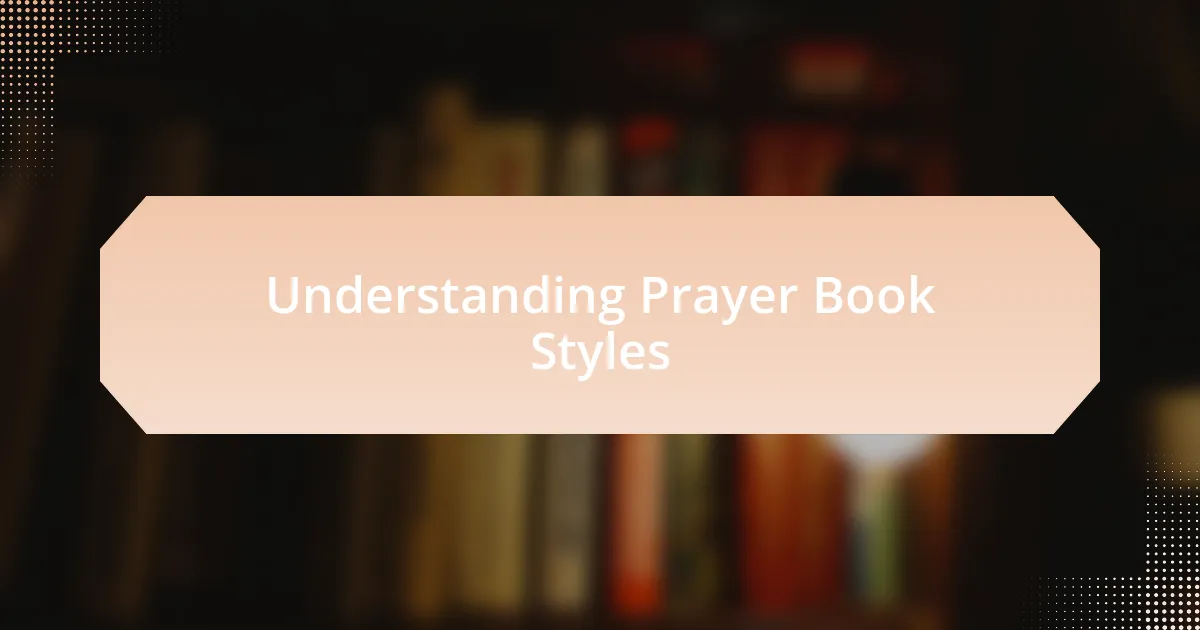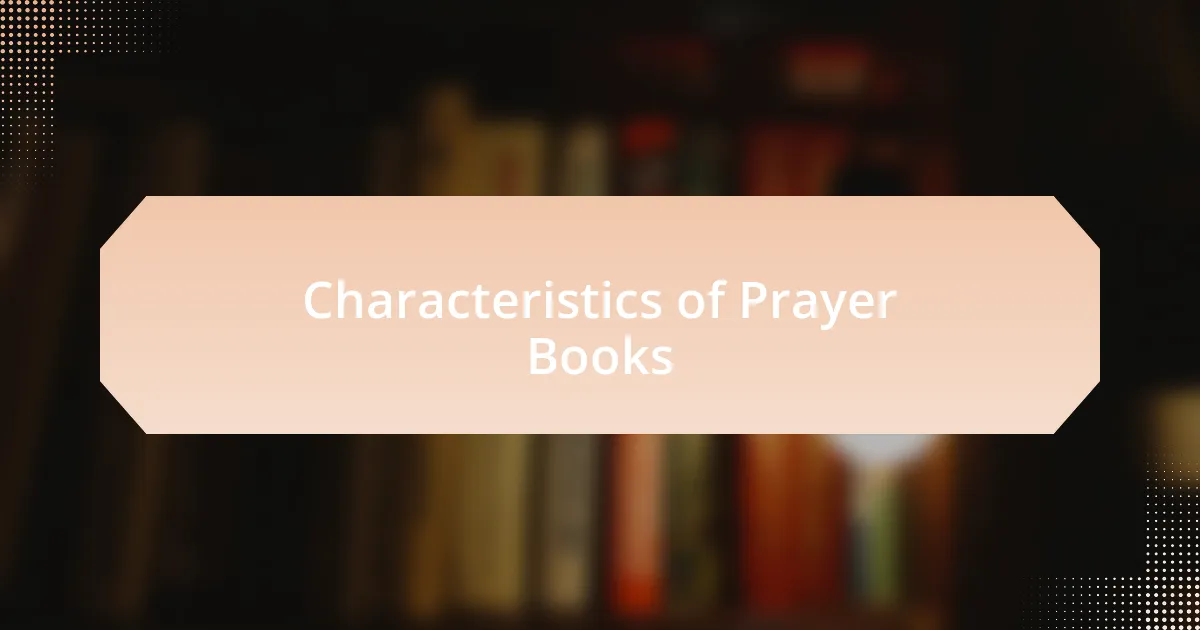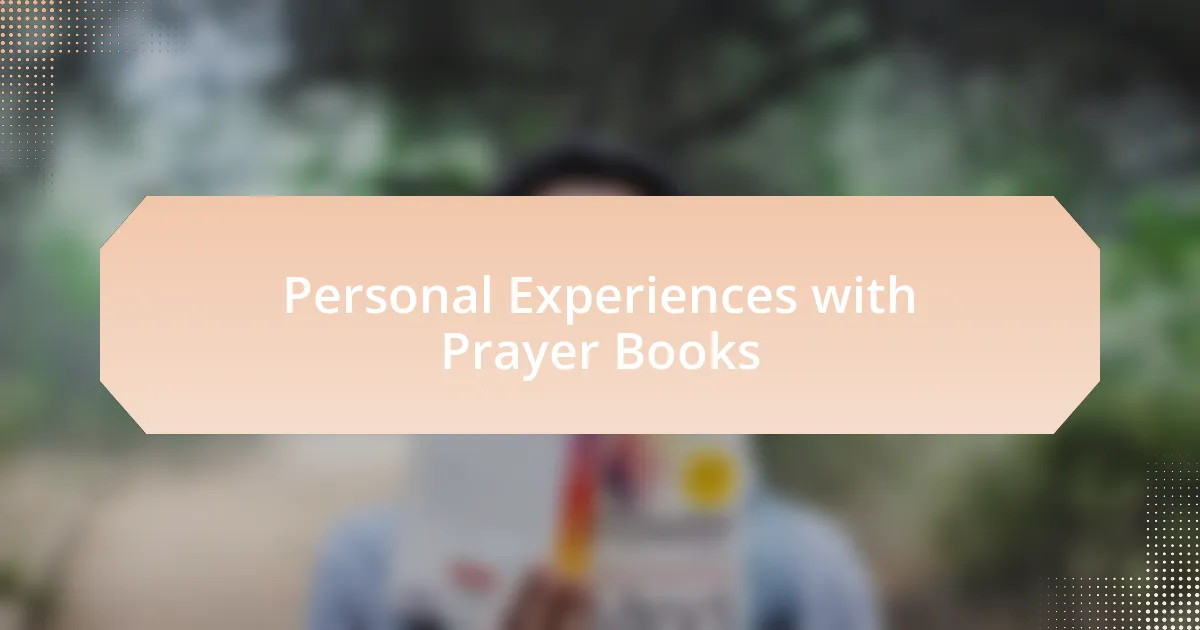Key takeaways:
- Religious books are dynamic texts that evolve with personal experiences, providing wisdom and solace throughout spiritual journeys.
- Prayer serves as a vital connection between believers and the divine, acting as both a reflective practice and a communal ritual.
- Different styles of prayer books, from structured to interactive, offer diverse ways for individuals to engage deeply with their spirituality.
- Personal experiences with prayer books enhance connection to self and others, showcasing how these texts can facilitate communal bonding and individual reflection.

Overview of Religious Books
Religious books serve as a profound reservoir of wisdom and tradition, guiding believers through their spiritual journeys. I remember the first time I opened a sacred text—I felt a wave of combined reverence and curiosity wash over me, as if I were peering into the thoughts of great minds throughout history. Have you ever felt that sense of connection when reading something that resonates deeply within you?
These texts come in various forms, reflecting the diverse practices and beliefs across cultures. Whether it’s the comforting rhythms of prayer books or the intricate narratives of sacred stories, each book offers unique insights into the human experience. I often find myself amazed at how these texts can address our deepest fears, hopes, and questions, often providing solace in moments of uncertainty.
Moreover, religious books aren’t just historical artifacts; they are living documents, constantly interpreted and reinterpreted. I find it fascinating how a text I read years ago can take on new meanings as I encounter different life experiences. Isn’t it remarkable how words can evolve with us, molding to the shape of our personal journeys while retaining their original essence?

Importance of Prayer in Religion
Prayer holds a central place in many religions, acting as a vital link between the believer and the divine. I remember a particularly emotional day when I turned to prayer, feeling utterly lost. It was through those heartfelt words that I felt a sense of peace wash over me, reinforcing my belief that prayer is not just an act but a dialogue that nurtures our spiritual lives.
In various traditions, prayer can take many forms, from structured petitions to spontaneous expressions of gratitude. During a community gathering, I once witnessed how collective prayer transformed the atmosphere, creating an overwhelming sense of unity and support. Have you ever experienced that shift in energy when a group comes together for a common purpose through prayer? It’s as if the air thickens with hope and intention, illustrating just how important these rituals are to foster connections.
Ultimately, prayer is about more than seeking help or expressing thanks; it serves as a powerful tool for reflection and growth. I often use prayer time as a moment to examine my thoughts and emotions, similar to journaling but with a spiritual twist. This practice has been enlightening, showing me that prayer can be an active process of understanding oneself, rather than merely a passive act of devotion. Isn’t it incredible how something so simple can carry such profound significance?

Understanding Prayer Book Styles
Understanding the different styles of prayer books can significantly enhance one’s spiritual experience. I’ve always found it fascinating how some prayer books are filled with structured prayers and rituals, providing a roadmap for the devout. For instance, I remember thumbing through a beautifully illustrated book one quiet evening. The order and design drew me in, guiding me through a meditative practice that felt both grounding and enlightening.
In contrast, I’ve encountered more contemporary prayer books that emphasize personal reflection and spontaneity. These books often encourage writing one’s thoughts and prayers, which I find incredibly liberating. Have you ever paused to jot down your feelings during prayer? For me, this form allows my heart to speak freely, transforming the experience into a unique conversation with the divine.
Exploring various prayer book styles has taught me the beauty of blending tradition with personal expression. I once attended a retreat where participants brought their favorite prayer books and shared insights. There, I realized that each prayer style not only reflects cultural history but also personal journeys. Isn’t it amazing how an ancient practice can adapt and resonate differently with each person?

Characteristics of Prayer Books
Prayer books exhibit distinct characteristics that cater to various spiritual needs and preferences. I’ve noticed that many traditional prayer books adhere to a structured format, often organized by themes or seasons. This organization can be comforting, as it creates a familiar rhythm for worship. On a chilly Sunday morning, I recall wrapping my hands around one of these tomes, flipping to the day’s prayers, which lent a sense of continuity that emanated warmth and nostalgia.
Conversely, some prayer books prioritize a more interactive style, encouraging users to engage deeply with their thoughts. For example, I once stumbled upon a prayer book that included blank pages for personal entries. I discovered that filling those pages with my reflections transformed my spiritual practice into a deeply personal journey. Have you ever felt a rush of expression while writing your innermost thoughts? It’s fascinating how this creative engagement can make prayer feel less like a ritual and more like a living conversation.
Moreover, the inclusion of visual elements often enhances the experience. I remember a prayer book adorned with stunning illustrations and poetry that resonated with my soul. These artistic elements sometimes evoke powerful emotions and can even lead to unexpected moments of inspiration during prayer. Isn’t it intriguing how beauty within a prayer book can deepen our connection to the divine? Through these various characteristics, we see how prayer books can serve not just as tools for devotion but as companions on our spiritual journeys.

Personal Experiences with Prayer Books
There’s something deeply personal about the moments I’ve spent with prayer books. One particular evening stands out in my memory. I found myself sprawled across my living room floor, surrounded by several prayer books. As I turned the pages of a small, well-loved book, the scent of aged paper filled the air, wrapping me in a comforting embrace. I realized that each word resonated with my current struggles and joys, reaffirming my belief that the right prayer book can serve as a mirror to our souls. Have you ever felt a book speak directly to your heart in such a way?
In my journey, I’ve also encountered prayer books that challenged my understanding of spirituality. I vividly recall opening a contemporary prayer guide that incorporated social justice themes. At first, I felt a tinge of resistance—prayer had always seemed so personal and inward. However, as I delved deeper into its pages, I found myself inspired to reflect on the world around me. It was a transformative experience, reminding me that prayer can be an expression of our hopes for others as much as it’s about our own petitions. Isn’t it fascinating how a change in perspective can shift our approach to prayer?
Finally, I cherish the times I’ve used prayer books to connect with others. During a retreat, my group shared passages from our favorite prayer books, creating a tapestry of voices and experiences. I remember feeling a sense of unity as we explored different interpretations and insights. The shared experience of prayer books turned solitary moments into communal ones, enhancing our connection not just with the divine, but with each other. Have you ever shared your favorite prayers with someone and felt a bond strengthen as a result?